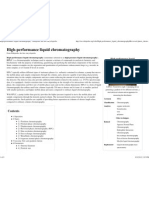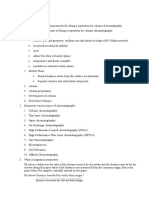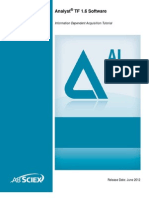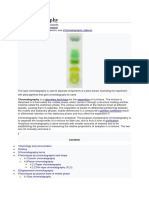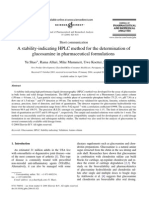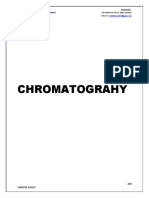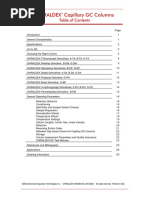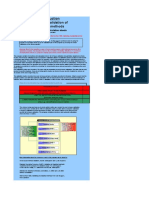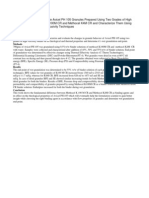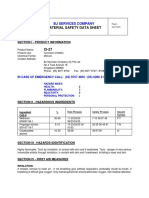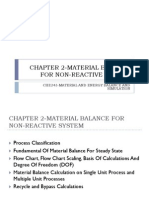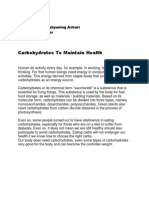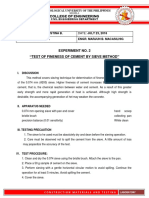0 ratings0% found this document useful (0 votes)
342 viewsChiral Chromatography
Chiral Chromatography
Uploaded by
HimChiral chromatography is a technique used in the pharmaceutical industry to separate chiral compounds (enantiomers) that are mirror images of each other. It involves using a chiral stationary phase or chiral mobile phase additive that interacts differently with the two enantiomers allowing their separation. Common chiral stationary phases used are polysiloxanes, metal chelates, cyclodextrins, proteins, and small chiral molecules bonded to silica. Applications include determining enantiomeric excess of drugs, analysis of foods, flavors and fragrances, and purification of chiral pharmaceuticals for clinical development.
Copyright:
© All Rights Reserved
Available Formats
Download as DOCX, PDF, TXT or read online from Scribd
Chiral Chromatography
Chiral Chromatography
Uploaded by
Him0 ratings0% found this document useful (0 votes)
342 views4 pagesChiral chromatography is a technique used in the pharmaceutical industry to separate chiral compounds (enantiomers) that are mirror images of each other. It involves using a chiral stationary phase or chiral mobile phase additive that interacts differently with the two enantiomers allowing their separation. Common chiral stationary phases used are polysiloxanes, metal chelates, cyclodextrins, proteins, and small chiral molecules bonded to silica. Applications include determining enantiomeric excess of drugs, analysis of foods, flavors and fragrances, and purification of chiral pharmaceuticals for clinical development.
Original Description:
j
Copyright
© © All Rights Reserved
Available Formats
DOCX, PDF, TXT or read online from Scribd
Share this document
Did you find this document useful?
Is this content inappropriate?
Chiral chromatography is a technique used in the pharmaceutical industry to separate chiral compounds (enantiomers) that are mirror images of each other. It involves using a chiral stationary phase or chiral mobile phase additive that interacts differently with the two enantiomers allowing their separation. Common chiral stationary phases used are polysiloxanes, metal chelates, cyclodextrins, proteins, and small chiral molecules bonded to silica. Applications include determining enantiomeric excess of drugs, analysis of foods, flavors and fragrances, and purification of chiral pharmaceuticals for clinical development.
Copyright:
© All Rights Reserved
Available Formats
Download as DOCX, PDF, TXT or read online from Scribd
Download as docx, pdf, or txt
0 ratings0% found this document useful (0 votes)
342 views4 pagesChiral Chromatography
Chiral Chromatography
Uploaded by
HimChiral chromatography is a technique used in the pharmaceutical industry to separate chiral compounds (enantiomers) that are mirror images of each other. It involves using a chiral stationary phase or chiral mobile phase additive that interacts differently with the two enantiomers allowing their separation. Common chiral stationary phases used are polysiloxanes, metal chelates, cyclodextrins, proteins, and small chiral molecules bonded to silica. Applications include determining enantiomeric excess of drugs, analysis of foods, flavors and fragrances, and purification of chiral pharmaceuticals for clinical development.
Copyright:
© All Rights Reserved
Available Formats
Download as DOCX, PDF, TXT or read online from Scribd
Download as docx, pdf, or txt
You are on page 1of 4
Chiral chromatography and its application to the pharmaceutical industry
Terms used in the chiral chromatography:
1) Chiral stationary phase: A stationary phase which incorporates a chiral selector. If not a
constituent of the stationary phase as a whole, the chiral selector can be chemically bonded to
(chiral bonded stationary phase)or immobilized onto the surface of a solid support or column
wall (chiral coated stationary phase),or simply dissolved in the liquid stationary phase.
2) Chiral selector: The chiral component of the separation system capable of interacting
enantioselectively with the enantiomers to be separated.
3) Chiral additive: The chiral selector which has been added as a component of a mobile phase or
electrophoretic medium.
4) Chiral mobile phase: A mobile phase containing a chiral selector
The most effective separation techniques that can be used for the analysis of enantiomers are
chromatography and electrophoresis. However, separation can only be achieved by using chiral
agents in the separation process.
Two substances can only be separated if their standard energy of distribution differ, which
means that their standard enthalpies and/or their standard entropies of distribution also differ.
For any chiral separation the stationary phase is chosen such that the spatial arrangement of its
composite atoms results in the probability or proximity of interaction differing significantly
between the two enantiomers to be separated.
Separation of chiral compounds typically is performed using by capillary electrophoresis and
chromatographic techniques such as HPLC, GC, and SFC.
The Mechanism of Solute Retention:
The retention of a solute is directly related to the volume of stationary phase available and this
is rarely the same as the total amount of stationary phase present in the column.
The available stationary phase is limited by the porosity of the support (only those molecules
small enough to enter the pores can interact with the stationary phase) and the chiral
characteristics (spatial arrangement) of the stationary phase.
Only those molecules having the appropriate spatial arrangement will achieve close interaction
with the stationary phase molecules or surface.
Conversely, those solute molecules of opposite chirality will be partially hindered from close
interaction with the stationary phase or surface, and experience reduced interaction.
Retention depends on
(1) The magnitude of the interactive forces between the molecule and the two phases,
(2) The change in the random nature of the solute molecule when it transfers from one phase
to the other
(3) Theavailability of the stationary phase, which will depend on the exclusion properties of the
support and the chiral nature of the surface.
Gas Chromatography Chiral Stationary Phases:
Chiral Polysiloxane Stationary Phases
Chiral Metal Chelating Stationary Phases
Cyclodextrin Chiral Stationary Phases:
1. In the case of the cyclodextrins, the chiral selectivity will vary with the type of
cyclodextrin and the type of solute derivative that is used.
2. Due to the structure of the cyclodextrins, retention can result from interactions arising
from inclusion or exclusion of the solute from the natural cavities contained by the
molecule.
3. The best phase system is usually determined by experiment and will not only be
influenced by the stationary phase selected, but also the type of solute derivative that
is employed.
Liquid Chromatography chiral stationary phases:
There are five general types of LC chiral stationary phases. They are:
1. Protein based phases bonded to silica,
2. Small molecular weight chiral compounds bonded to silica (the Pirkle phases),
3. Cellulose and amylose polymers type phases that are coated onto silica gel,
4. Macrocyclic glycopeptides that are bonded to silica and
5. Cyclodextrin based materials that are also bonded to silica.
There are several protein type stationary phases, a1-acid glycoprotein, cellobiohydralase
and human serum albumin being examples.
These stationary phases are used with mobile phases with a high water content (mostly >
90%) and thus separations are largely by dispersive interactions.
There are quite a large number of small chiral molecules that are used as Pirkle stationary
phases, some of the more common being the substituted urea carbamates. These types of
stationary phases can be operated either in the reversed phase mode or the normal mode.
The cellulose or amylose polymers are derivatized in order to link groups such as
carbamates or benzoates to the free hydroxylgroups.
The cyclodextrin phases can be made form a, b or g cyclodextrins and offer a large number
of chiral centers and, as result of their unique structure, contain a number of substantially
deep inclusion centers.
These inclusion centers allow selective intrusion by appropriately sized molecules and thus
can play an important part in chiral selectivity.
Applications
1) Indirect Enantiomeric Resolution:
It involves the coupling of the enantiomers with an auxiliary chiral reagent to convert them into
diastereomers. The diastereomers can then be separated by any achiral separation technique.
2) Direct Enantiomeric Resolutions:
Direct enantiomeric resolutions are only feasible in chromatographic systems which
contain an appropriate chiral selector.
The chiral selector can be incorporated into the stationary phase that is chiral stationary
phase or be permanently bonded to or coated onto the surface of the column packing
material, chiral bonded and chiral coated stationary phases.
3) Enantioselective chromatography
a) On chiral stationary phases
In the case of chiral stationary phases, the enantiomer that forms the more stable association
with the chiral selector will be the more strongly retained species of the racemate.
The enantioselectivity of the chiral chromatographic system is then expressed as the ratio of the
retention factors of the two enantiomers.
b) On achiral stationary phases
Enantioselective chromatography can also be performed on achiral chromatographic
columns using the required chiral selector as a chiral mobile phase or a chiral mobile phase
additive.
A chiral mobile phase reduces the retention of the solute enantiomer which forms a
stronger association with the chiral selector.
The effective enantioselectivity of the chromatographic system will therefore be
proportional to the ratio of the enantioselectivities of the association processes in the
stationary and mobile phases.
These differ in their thermodynamic stability, provided that at least three active points of
the selector participate in the interaction with corresponding sites of the solute molecule.
This three-point interaction rule is generally valid for enantioselective chromatography.
Enantioselective chromatography and capillary electrophoresis are extensively employed in the
analysis of the enantiomeric composition (enantiomeric excess, optical purity) of chiral
compounds.
Other Applications:
Chiral gas chromatography is one of the most frequently used techniques for the analysis of
essential oils.
It is used for the analysis of food and beverages, flavors, perfumes and medicinal oils.
Due to the importance of chirality in the physiological response of many drugs, chiral gas
chromatography is routinely used in drug analysis.
The technique can be applied to the analysis of all types of spatial isomers, not merely those
with chiral carbon atoms.
Chiral gas chromatography also has a wide field of application in research, in environmental
studies and environmental monitoring, in biochemistry and biotechnology, in forensic science
and in all types of quality control.
Use of chiral chromatography for rapid compound screening and compound purification, will
allow rapid elimination of racemic compounds with undesirable characteristics.
Preparative and semi-preparative separations for pre-clinical and early clinical development will
continue to be the fast growing area.
The single biggest application would be the analytical separation and preparative purification of
chiral pharmaceuticals
You might also like
- Vitamin ChartDocument5 pagesVitamin ChartHimNo ratings yet
- Wang Andy Session 21Document45 pagesWang Andy Session 21windli2014100% (1)
- Tds - Macgrid BiaxialDocument1 pageTds - Macgrid BiaxialLiliana Ribeiro100% (2)
- TCVN 6486Document14 pagesTCVN 6486Nguyen Duc Thien PhucNo ratings yet
- RP HPLCDocument9 pagesRP HPLCGoutam GhoshNo ratings yet
- Analytical Characterization of BiotherapeuticsFrom EverandAnalytical Characterization of BiotherapeuticsJennie R. LillNo ratings yet
- Biomolecular and Bioanalytical Techniques: Theory, Methodology and ApplicationsFrom EverandBiomolecular and Bioanalytical Techniques: Theory, Methodology and ApplicationsVasudevan RameshNo ratings yet
- Introduction To HPLCDocument40 pagesIntroduction To HPLCSunil KumarNo ratings yet
- 1-Chromatography Is A Separation Method in Which The Analyte Is Contained in A Mobile Phase and Pumped Through A Stationary Phase-Libre PDFDocument151 pages1-Chromatography Is A Separation Method in Which The Analyte Is Contained in A Mobile Phase and Pumped Through A Stationary Phase-Libre PDFWilson Xavier100% (1)
- Uplc HPLC: Pros and Cons Advantages of UPLC Over HPLCDocument1 pageUplc HPLC: Pros and Cons Advantages of UPLC Over HPLCSARAHI MOGUEL PEREZNo ratings yet
- 03.affinity Efficacy PotencyDocument33 pages03.affinity Efficacy Potencyelitechems100% (2)
- Application of Column Chromatography in PharmacyDocument5 pagesApplication of Column Chromatography in PharmacyJay Shah100% (3)
- HPLC Presentation1Document33 pagesHPLC Presentation1Muttu MNo ratings yet
- Screening Methods in Pharmacology. Volume II (1971) - Robert A. Turner and Peter HebbornDocument291 pagesScreening Methods in Pharmacology. Volume II (1971) - Robert A. Turner and Peter HebbornSiddharth Ahuja100% (1)
- 1.1 Analytical Chemistry: Introductio NDocument56 pages1.1 Analytical Chemistry: Introductio NmadhubaddapuriNo ratings yet
- Analysis QBDocument167 pagesAnalysis QBChethan PrabhuNo ratings yet
- Metformin+Glibenclamide Thesis PDFDocument114 pagesMetformin+Glibenclamide Thesis PDFnari9No ratings yet
- HPLC Method Development and ValidationDocument8 pagesHPLC Method Development and ValidationSebastian LopezNo ratings yet
- IDA TutorialDocument20 pagesIDA Tutorialhaben9036No ratings yet
- Chapter 3 NotesDocument10 pagesChapter 3 Notesmjamie12345No ratings yet
- HPLC Pharma 25-1-09-Numbered-All PrintDocument19 pagesHPLC Pharma 25-1-09-Numbered-All PrintshulalevinNo ratings yet
- UV Spectroscopy-NotesDocument43 pagesUV Spectroscopy-NotesvarishNo ratings yet
- Chromatography: Jump To Navigationjump To SearchDocument22 pagesChromatography: Jump To Navigationjump To SearchSaurabh BansalNo ratings yet
- PharmaceuticsDocument9 pagesPharmaceuticsHARI HARA RAO GUJJARNo ratings yet
- University College of Pharmaceutical SciencesDocument52 pagesUniversity College of Pharmaceutical SciencesThilak ChandraNo ratings yet
- Methods of Estimation of MultiDocument41 pagesMethods of Estimation of Multiapi-19786321100% (1)
- Seminar On HPLC: Submitted To: Submitted byDocument35 pagesSeminar On HPLC: Submitted To: Submitted byAnup ShawNo ratings yet
- Toxicology Compendium PDFDocument602 pagesToxicology Compendium PDFJUANNo ratings yet
- Advanced Pharmaceutical AnalysisDocument4 pagesAdvanced Pharmaceutical AnalysisRezaul RazibNo ratings yet
- Fundamental LC-MS Orbitrap Mass Analyzers PDFDocument30 pagesFundamental LC-MS Orbitrap Mass Analyzers PDFAlonso HurtadoNo ratings yet
- HPTLC SeminarDocument23 pagesHPTLC SeminarAzim Arshi100% (9)
- Pharmaco Go NosyDocument135 pagesPharmaco Go NosyNomi100% (1)
- Updated ICP-MS Guidelines For Troubleshooting and MaintenanceDocument29 pagesUpdated ICP-MS Guidelines For Troubleshooting and Maintenancetaufikiskandar1705No ratings yet
- Chiral PharmacologyDocument33 pagesChiral Pharmacologysar86100% (1)
- 논문 - A stability-indicating HPLC method for the determination of glucosamine in pharmaceutical formulationsDocument7 pages논문 - A stability-indicating HPLC method for the determination of glucosamine in pharmaceutical formulationsjs_kim5781No ratings yet
- Lab HPLC - Overdose of Paracetamol (Acetaminophen)Document3 pagesLab HPLC - Overdose of Paracetamol (Acetaminophen)Zharif NizamNo ratings yet
- Chromatograhy: 289 Sandeep KaileyDocument44 pagesChromatograhy: 289 Sandeep KaileyVizit DubeyNo ratings yet
- Supercritical Fluid Chromatography (SFC)Document32 pagesSupercritical Fluid Chromatography (SFC)masruri123No ratings yet
- HPLC Troubleshooting: Spinco Biotech PVT LTDDocument34 pagesHPLC Troubleshooting: Spinco Biotech PVT LTDskvemulaNo ratings yet
- Preliminary Phytochemical Screening and Antidiabetic Activity of Extracts of Leaves of Crinum Latifoliumlinn.Document45 pagesPreliminary Phytochemical Screening and Antidiabetic Activity of Extracts of Leaves of Crinum Latifoliumlinn.Mohd Habeeb AhmadNo ratings yet
- Review Hyphenation in Sample Preparation: Advancement From The Micro To The Nano WorldDocument14 pagesReview Hyphenation in Sample Preparation: Advancement From The Micro To The Nano WorldNoorfatimah YahayaNo ratings yet
- Sheryl A. Rummel, Kristin M. Beiswenger - Chemistry 213 Introductory Organic Chemistry Laboratory 2015-2016. Lab Guide-Hayden McNeil (2016)Document359 pagesSheryl A. Rummel, Kristin M. Beiswenger - Chemistry 213 Introductory Organic Chemistry Laboratory 2015-2016. Lab Guide-Hayden McNeil (2016)Camilo Andres Espinosa RomeroNo ratings yet
- Handbook of Organic Compounds (Sigma)Document52 pagesHandbook of Organic Compounds (Sigma)ahmet11100% (1)
- 50 Years of HPLCDocument6 pages50 Years of HPLCCamilo LaraNo ratings yet
- Instrumental Chemical AnalysisDocument39 pagesInstrumental Chemical AnalysisparthabakalNo ratings yet
- Toxicology Procedures ManualDocument246 pagesToxicology Procedures Manualdiyanalungu89No ratings yet
- Chromatography HPLCDocument16 pagesChromatography HPLCFilia YunizaNo ratings yet
- J PH & Bio AnalysisDocument9 pagesJ PH & Bio AnalysisMaría Belén OlivarezNo ratings yet
- Notes PDFDocument9 pagesNotes PDFZaheer UllahNo ratings yet
- Chiral Separations by Liquid Chromatography (Acs Symposium SeriesDocument244 pagesChiral Separations by Liquid Chromatography (Acs Symposium SeriesbilalNo ratings yet
- In-House Validation of Analytical Methods: Procedures & Calculation SheetsDocument21 pagesIn-House Validation of Analytical Methods: Procedures & Calculation SheetsZ0Z999No ratings yet
- Introduction To Infrared SpectrsDocument36 pagesIntroduction To Infrared SpectrsIntanNabilaNo ratings yet
- 2.2.46. Chromatographic Separation TechniquesDocument5 pages2.2.46. Chromatographic Separation TechniquesFemmes RêveurNo ratings yet
- Extraction of Some Secondary Metabolites & Thin Layer Chromatography From Different Parts of Centella Asiatica L.Document5 pagesExtraction of Some Secondary Metabolites & Thin Layer Chromatography From Different Parts of Centella Asiatica L.yayax_619No ratings yet
- PesticidesDocument416 pagesPesticidesMehmet AydinNo ratings yet
- LCMS Introduction Part 2Document34 pagesLCMS Introduction Part 2rostaminasabNo ratings yet
- Finlay MacRitchie - Concepts in Cereal Chemistry-CRC Press (2010) PDFDocument192 pagesFinlay MacRitchie - Concepts in Cereal Chemistry-CRC Press (2010) PDFEdward PinedaNo ratings yet
- PharmacokineticsDocument32 pagesPharmacokineticsmursidstone.mursid67% (3)
- Biological StandardizationDocument11 pagesBiological StandardizationJames Ugbes100% (1)
- LC MSDocument69 pagesLC MSBrahmeshNo ratings yet
- Liquid Chromatography - Mass Spectrometry: An IntroductionFrom EverandLiquid Chromatography - Mass Spectrometry: An IntroductionNo ratings yet
- Formulation and Invitro Evaluation of Salbutamol Sulphate in Situ Gelling Nasal Inserts. Aaps Pharm. Scitech. 2013,14, (2), 712-718Document1 pageFormulation and Invitro Evaluation of Salbutamol Sulphate in Situ Gelling Nasal Inserts. Aaps Pharm. Scitech. 2013,14, (2), 712-718HimNo ratings yet
- Validation of Compressed Air Introduction: Compressed Air Has Wide Applications in Various Industries. in Pharmaceutical IndustryDocument1 pageValidation of Compressed Air Introduction: Compressed Air Has Wide Applications in Various Industries. in Pharmaceutical IndustryHimNo ratings yet
- PurposeDocument1 pagePurposeHimNo ratings yet
- Tem Intro PDFDocument12 pagesTem Intro PDFHimNo ratings yet
- NERVOUS MnemonicsDocument4 pagesNERVOUS MnemonicsHimNo ratings yet
- Best GuidelinesDocument0 pagesBest GuidelinesHimNo ratings yet
- Easy Way To Determine R, S ConfigurationDocument11 pagesEasy Way To Determine R, S ConfigurationHimNo ratings yet
- Bpharm Final Year Syllabus Mumbai UnivDocument21 pagesBpharm Final Year Syllabus Mumbai UnivHArsh ModiNo ratings yet
- 3236 91143 Test Organism For Assay of DrugsDocument1 page3236 91143 Test Organism For Assay of DrugsHimNo ratings yet
- Chapter 10, CBSDocument46 pagesChapter 10, CBSHimNo ratings yet
- Methods of MiningDocument5 pagesMethods of MiningJunel Alapa0% (1)
- Refrigerant Leakage and Its DetectionDocument8 pagesRefrigerant Leakage and Its DetectionDeepak0% (1)
- Ci 27Document5 pagesCi 27afzal7No ratings yet
- Carbonyl Compounds Aldehydes and Ketones2Document6 pagesCarbonyl Compounds Aldehydes and Ketones2Sachitra WijethungaNo ratings yet
- Report On Brick - 1Document6 pagesReport On Brick - 1Meghashree100% (1)
- V-18 Last 3 Cargo & Tank Cleaning Method Update (Fill Ratio)Document1 pageV-18 Last 3 Cargo & Tank Cleaning Method Update (Fill Ratio)Aung Htet KyawNo ratings yet
- Sample Qp12Document41 pagesSample Qp12suchetha manjunthaNo ratings yet
- Superabsorbent Polymer Lesson PlanDocument11 pagesSuperabsorbent Polymer Lesson PlanSiddarth AshokNo ratings yet
- Guidelinesfor Fabricating&Processing Plate SteelDocument97 pagesGuidelinesfor Fabricating&Processing Plate SteelFIM SA100% (1)
- 80-GE-MFB-001 (Rev A0) P&ID - Process Flow DiagramDocument1 page80-GE-MFB-001 (Rev A0) P&ID - Process Flow Diagrama_mohid17No ratings yet
- Student CHAPT 2Document46 pagesStudent CHAPT 2Sharifah Zulaikha BenYahyaNo ratings yet
- Manual For SP1 7890-0552 PDFDocument30 pagesManual For SP1 7890-0552 PDFvzimak2355No ratings yet
- Sodium and Potassium Silicates Brochure ENG Oct 2004Document16 pagesSodium and Potassium Silicates Brochure ENG Oct 2004Lekhamani Yadav0% (1)
- Effectsofmodernagriculture 140404092000 Phpapp01Document32 pagesEffectsofmodernagriculture 140404092000 Phpapp01Shailendra GuptaNo ratings yet
- Tugas WritingDocument2 pagesTugas WritingNurull Nichlany CyrilNo ratings yet
- 2.3 Guided Notes With AnswersDocument3 pages2.3 Guided Notes With Answersparam sivam100% (1)
- Renalin 100 DFU50090-679 Rev DDocument24 pagesRenalin 100 DFU50090-679 Rev DOscar Aguilar SanchezNo ratings yet
- Riscuri de Incendiu Asociate Cu RezervoareleDocument14 pagesRiscuri de Incendiu Asociate Cu RezervoareleanaismariaNo ratings yet
- Manual K50 Sectional Machine ManDocument47 pagesManual K50 Sectional Machine ManeliezerperezNo ratings yet
- 14.catalogue Prv-Cat-16-ExDocument4 pages14.catalogue Prv-Cat-16-ExNicolas GallegosNo ratings yet
- Apéndice Entalpías Perry + Felder + HimmelblauDocument7 pagesApéndice Entalpías Perry + Felder + HimmelblauJared LondoNo ratings yet
- Dissertation Fuel CellDocument5 pagesDissertation Fuel CellWhereCanIFindSomeoneToWriteMyCollegePaperUK100% (1)
- Mass Transfer & Porous MediaDocument98 pagesMass Transfer & Porous MediaCoraNo ratings yet
- Phloem Transport LecDocument84 pagesPhloem Transport LecTallia LewisNo ratings yet
- VIẾT LẠI CÂU SAO CHO NGHĨA KHÔNG THAY ĐỔIDocument5 pagesVIẾT LẠI CÂU SAO CHO NGHĨA KHÔNG THAY ĐỔItruonghang13188No ratings yet
- Experiment 2Document4 pagesExperiment 2Ynah CasiaNo ratings yet
- 5-3-acids-bases--buffers-I7H07FIyCjle-vNKDocument38 pages5-3-acids-bases--buffers-I7H07FIyCjle-vNKa7wiyaNo ratings yet
- Below Grade Spill Containment Manholes - Franklin Fueling SystemsDocument8 pagesBelow Grade Spill Containment Manholes - Franklin Fueling Systemswarung1bensinNo ratings yet




